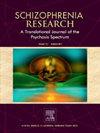Age- and sex-dependent effects of stressors on activity of the nucleus reuniens of the thalamus
IF 3.5
2区 医学
Q1 PSYCHIATRY
引用次数: 0
Abstract
Background
Stress is a significant socio-environmental risk factor for schizophrenia, with its impact varying with age and sex. Male rats are more vulnerable to the long-term effecct of stress during early adolescence, whereas females are more affected during late adolescence, with both demonstrating a stress-induced hyperdopaminergic state and ventral hippocampal hyperexcitability. The nucleus reuniens of the thalamus (RE) plays a crucial role in modulating hippocampal-prefrontal connectivity and dopamine activity. This study investigated the effect of stress during neurodevelopment on RE activity in both sexes.
Study design
Sprague-Dawley rats were subjected to a 10-day footshock and restraint stress protocol during early adolescence (Post-natal day [PD] 31–40) or late adolescence (PD41–50) periods. Electrophysiological RE recordings were conducted 1–2 and 5–6 weeks post-stress.
Study results
Early adolescence stress did not affect the number of spontaneously active RE neurons in males and females after 1–2 or 5–6 weeks, but it increased the proportion of RE neurons firing in bursts in females. Late adolescence stress increased the number of spontaneously active RE neurons in females at both 1–2 and 5–6 weeks. Females had fewer active RE neurons than males starting earlier in adulthood but not at a younger age (PD47–54). This shows an age-dependent effect on female RE activity.
Conclusion
Stress had sex-specific effects on RE neuron activity of females, with late adolescence stress increasing the number of spontaneous RE neurons, while early adolescence stress influenced burst firing. Therefore, stress-induced changes in RE activity during adolescence may contribute to females' vulnerability to neuropathology.
应激源对丘脑团聚核活动的年龄和性别依赖性影响
应激是精神分裂症的重要社会环境风险因素,其影响随年龄和性别的不同而不同。雄性大鼠在青春期早期更容易受到压力的长期影响,而雌性大鼠在青春期后期更容易受到影响,两者都表现出压力诱导的高多巴胺能状态和海马腹侧高兴奋性。丘脑团聚核(RE)在调节海马-前额叶连接和多巴胺活动中起着至关重要的作用。本研究探讨了神经发育过程中应激对两性RE活性的影响。研究设计sprague - dawley大鼠在青春期早期(产后[PD] 31-40)或青春期晚期(PD41 - 50)进行为期10天的足部电击和约束应激实验。应激后1-2周和5-6周进行电生理RE记录。研究结果青春期早期应激在1-2周和5-6周后对雄性和雌性自发激活的RE神经元数量没有影响,但增加了雌性RE神经元爆发放电的比例。青春期后期应激增加了雌性在1-2周和5-6周时自发活跃的RE神经元数量。女性在成年早期比男性有更少的活跃的RE神经元,但在更年轻的时候没有(PD47-54)。这显示了年龄对女性RE活动的影响。结论应激对女性RE神经元活性的影响存在性别差异,青春期后期应激增加自发性RE神经元数量,青春期早期应激影响突发放电。因此,青春期应激引起的RE活动变化可能导致女性易患神经病理学。
本文章由计算机程序翻译,如有差异,请以英文原文为准。
求助全文
约1分钟内获得全文
求助全文
来源期刊

Schizophrenia Research
医学-精神病学
CiteScore
7.50
自引率
8.90%
发文量
429
审稿时长
10.2 weeks
期刊介绍:
As official journal of the Schizophrenia International Research Society (SIRS) Schizophrenia Research is THE journal of choice for international researchers and clinicians to share their work with the global schizophrenia research community. More than 6000 institutes have online or print (or both) access to this journal - the largest specialist journal in the field, with the largest readership!
Schizophrenia Research''s time to first decision is as fast as 6 weeks and its publishing speed is as fast as 4 weeks until online publication (corrected proof/Article in Press) after acceptance and 14 weeks from acceptance until publication in a printed issue.
The journal publishes novel papers that really contribute to understanding the biology and treatment of schizophrenic disorders; Schizophrenia Research brings together biological, clinical and psychological research in order to stimulate the synthesis of findings from all disciplines involved in improving patient outcomes in schizophrenia.
 求助内容:
求助内容: 应助结果提醒方式:
应助结果提醒方式:


